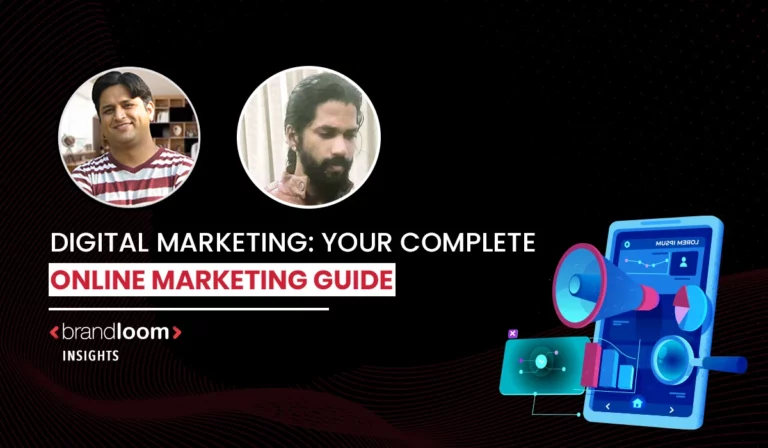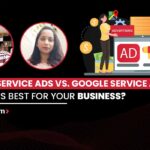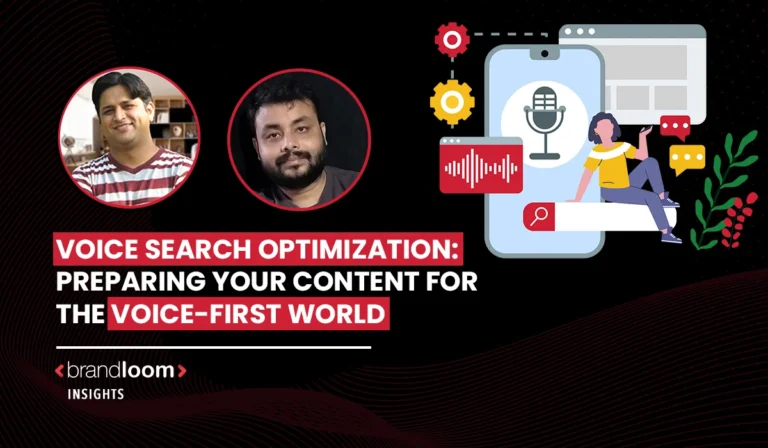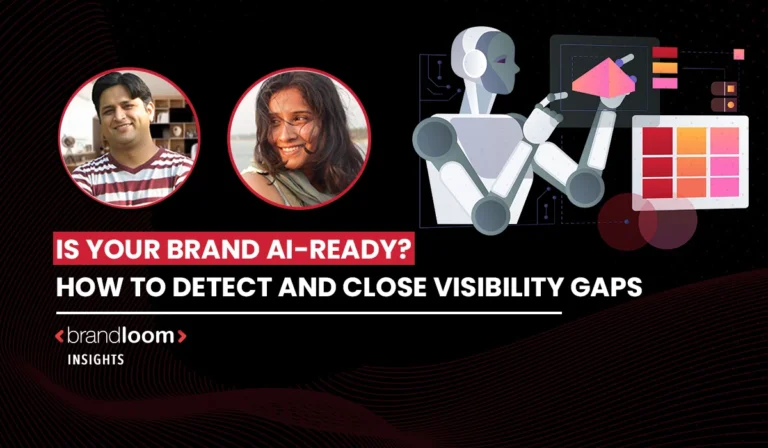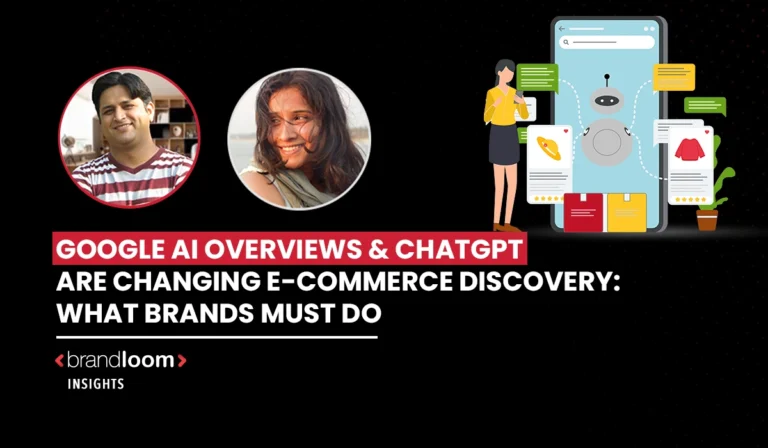Imagine you own a store that sells amazing and unique products, but not many people know about it. You’re stuck with no customers, even though your product could change their lives. That’s a huge problem for business owners, specifically in today’s world of technology.
If you are a business owner running a business currently in this stage, the solution to overcome this problem is digital marketing! Without it, you’re missing out on reaching millions of people who could be your next loyal customers.
Many business owners feel stuck in marketing because they are pouring time and money into traditional methods that don’t even work well anymore. At BrandLoom, we understand how troublesome this situation can be and we can help you out of this. Being one of the top digital marketing agencies in India, we have supported numerous businesses in improving their visibility online and getting new clients.
In this guide, let us understand digital marketing in detail and explore versatile strategies and types of digital marketing.
Digital Marketing Meaning & Definition: What Is Digital Marketing?
Let us start with a brief introduction to Digital Marketing.
Traditionally, marketing was done through mediums like newspaper ads and posters. With the advent of television and radio, marketing occupied that territory, too, and that’s how TV ads and radio came about. This is where we can assume the beginning of Digital Marketing to be.
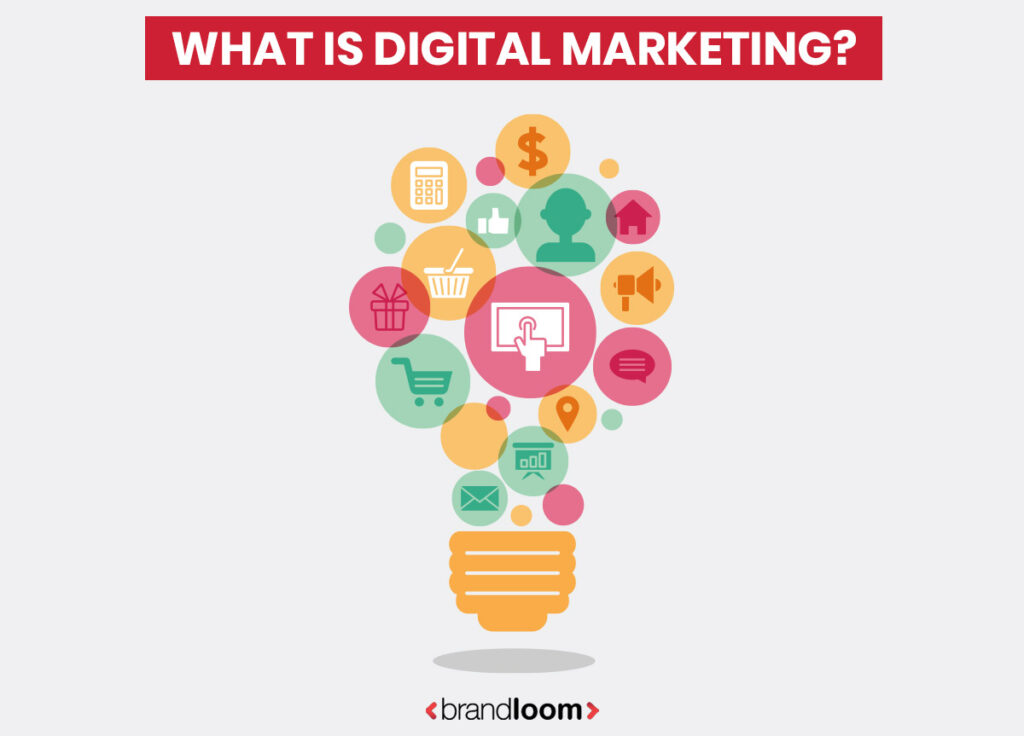
But today, by the term digital marketing, we are not referring to TV or radio ads; we are actually referring to online marketing. As the digital sphere developed with the internet and various social media platforms, the method of marketing changed gradually.
Digital marketing meaning & definition are simple. It refers to promoting your business using the internet, like social media, websites, and emails. In practice, it refers to the use of online marketing strategies and platforms that help advertisers market on digital devices like computer, smartphones, tablets etc.
Online marketers use various digital marketing channels like content marketing, email marketing, search engine optimization, search engine marketing (paid ads), social media marketing, and so on to execute their marketing strategies.
Digital marketing is frequently distinguished from “traditional marketing” methods such as magazine advertisements, billboards, and direct posts via written letter cards. Nowadays, television and radio ads are also frequently grouped with traditional marketing.
Digital marketing connects with people who are already looking for what you offer. It helps your products and services reach the right audience—people who are likely to become your customers. Without digital marketing, your business stays hidden while competitors take the spotlight.
Let’s explore how digital marketing can help your brand stand out and grow!
The BEST Branding & Digital Marketing Agency in USA, that can Bring Traffic, Customers & Cashflow To Your Business. Contact us Now!
What Is The Difference Between Traditional Marketing And Digital Marketing?
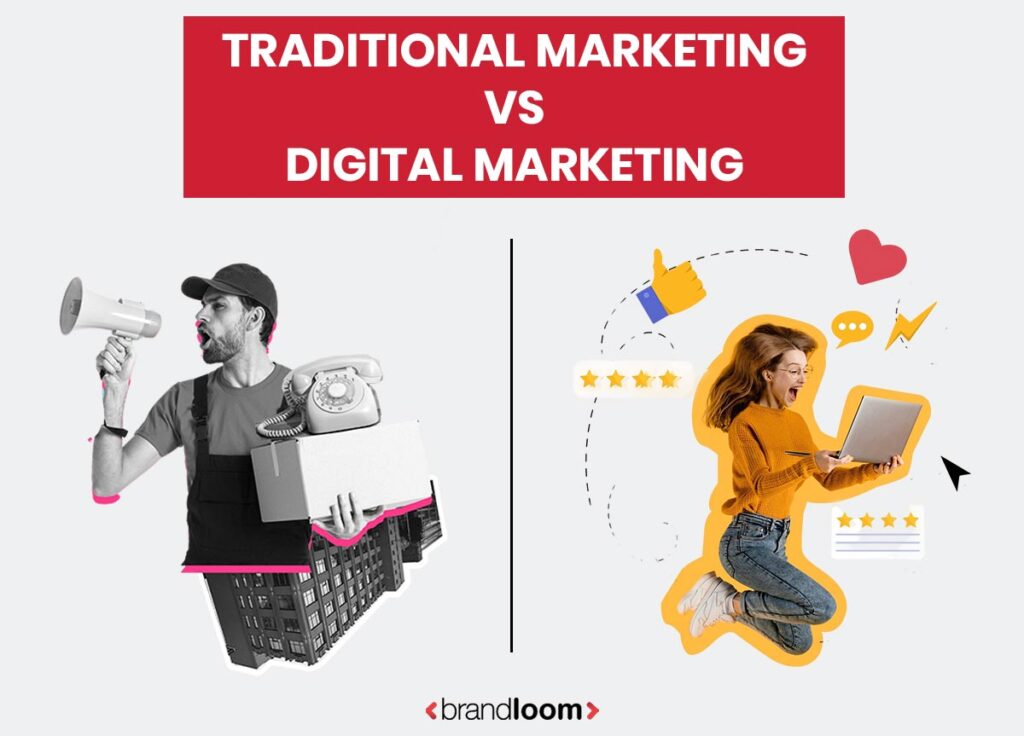
Here is an easy-to-understand distinction table for traditional marketing vs digital marketing
| Traditional Marketing | Digital Marketing |
| The modes of conversion used here are conventional. | Digital channels like social media, websites, and e-mail are used as the primary method of conversion. |
| The nature of this marketing technique is static. | This marketing technique is dynamic. You can easily adjust this to the needs of the product and the strategy. |
| This marketing technique has a very low conversion rate. | This marketing type has chances of a very high conversion rate. |
| The engagement is relatively lower. | The engagement is relatively higher. |
| ROI is less. | ROI is high. |
| The channel of communication here is one-sided. | Here, the channel of communication can be done from both sides. Even the customers can reach the product makers and marketers. And that too quite easily. |
| The cost of traditional marketing is way higher. It is not budget-friendly. | The cost of digital marketing is comparatively cheaper. It is budget-friendly. |
| Tracking is impossible to be done here. | Instant results tracking and performance tracking are possible with the help of modern tools. |
| The reach of this type of marketing is local or limited. | The reach is on a global scale. |
| The results are generally delayed. | The results are instant for most channels. |
Traditional Marketing Vs Digital Marketing
Digital Marketing Meaning and Definition: Major Channels of Digital Marketing
There are multiple digital marketing channels, and all of them are interconnected in some way. However, for ease of understanding, we can classify digital marketing into a few important channels, which are discussed below:
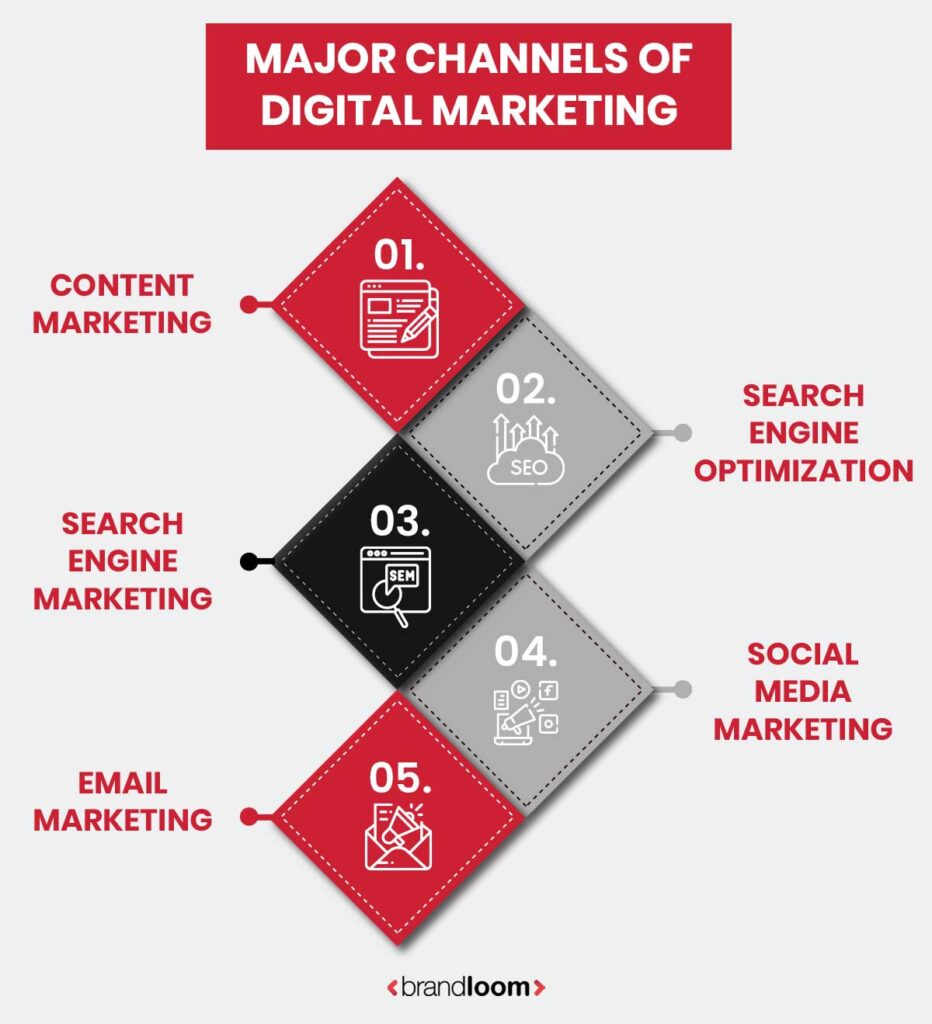
1. Content Marketing
This digital marketing term refers to promoting and creating content to increase traffic, lead generation, and brand awareness. Content marketing is utilized mainly through websites and social media.
Your website is a major hub of your digital marketing strategy. Brands use websites to host content, while other mediums distribute it. Most of your digital marketing efforts will always take you back to your website, where the action is expected to be taken, and conversions are to be tracked, for example, a file download, a product or service reservation, and so on.
A content marketing strategy includes the following channels:
- Blog posts — writing and publishing blog articles within a business blog will assist your brand in demonstrating your expertise and increasing organic search traffic. This increases your brand’s chances of converting site visitors into sales leads. Newsletters can also do the same through email marketing.
- Ebooks — this channel allows you to promote your content to get a reader’s contact information, generating leads and moving users along the buyer’s journey.
- Infographics – They are a type of visual content that can help your website visitors visualize a concept you want them to learn and understand quickly.
- Media – This may include videos or pictures. With new technology, podcasts can also fall under this.
Content marketing necessarily doesn’t mean advertising through written content. It can include a mix of audio-visual elements like text, images, GIFs, infographics, videos, animation and so on.
These give life and value to your brand and the marketing collaterals you use for branding.
The Best Digital Marketing Agency in Mumbai, That Will Make Your Profits Soar & Your Competitors Jealous. Contact us Now!
2. Search Engine Optimization (SEO)
This is one of the most crucial and overlooked channels of digital marketing. Search Engine Optimization (SEO) is optimizing your company’s website to rank higher, increasing the amount of organic traffic to your website.
In simple words, it is what brings your website to the top of Google’s results when someone searches for any particular keyword related to your product/ services.
Blogs, infographics, and websites are among the channels that help you attain the maximum benefits of SEO digital marketing.
There are several ways to use SEO to drive quality traffic to your website, including:
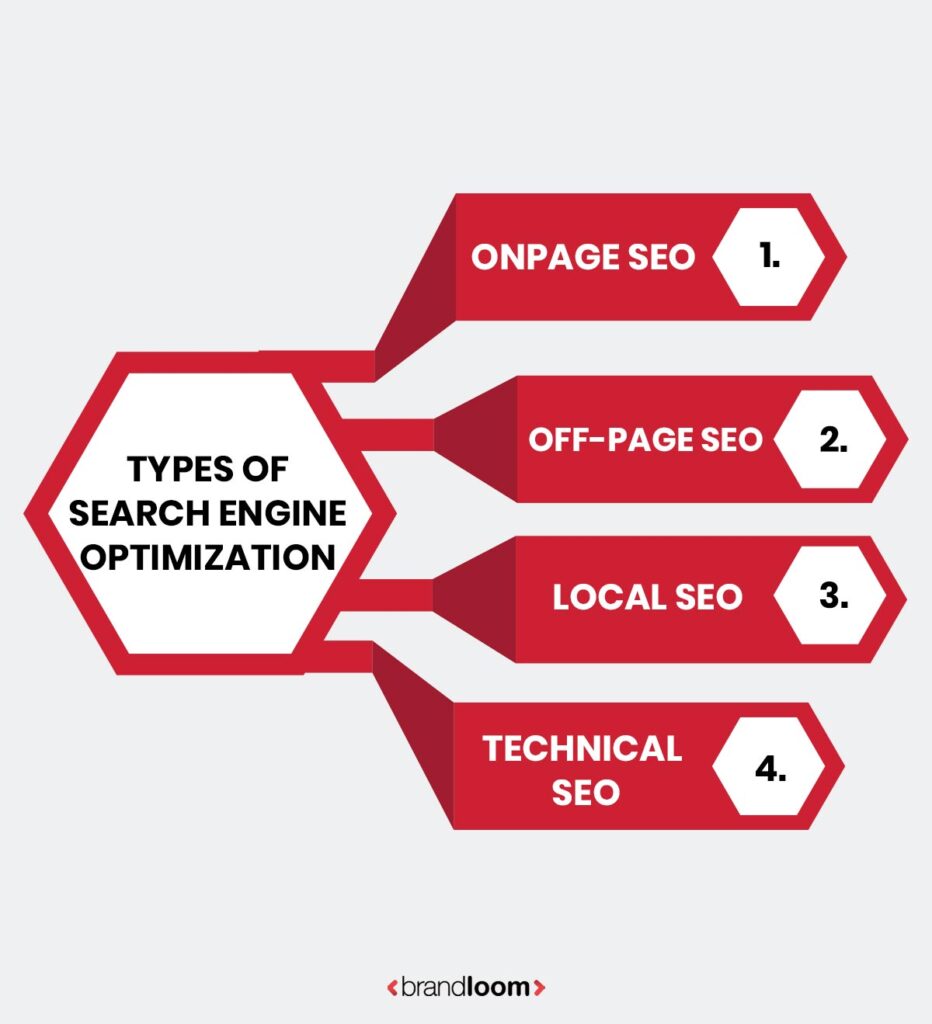
On-page SEO
It includes things like using the right keywords in your text, making sure your pages load quickly, and organizing your content so it’s easy for both people and search engines to understand.
By optimizing things like titles, headings, and images on your pages, you help search engines like Google know what your website is about and how to rank it. Simply put, on-page SEO is the group of activities you do on your own website to get noticed online.
Off-page SEO
Off-page is a digital marketing strategy that focuses on improving your website’s ranking through activities that happen outside your site. One key factor is backlinks, which are links from other websites to yours. The more websites that link to you and the more trusted and relevant those websites are, the higher you’ll rank for important keywords.
You can earn backlinks by connecting with other website owners, writing guest posts on different sites, and getting people noticed about your content through external sources. These actions help boost your website’s visibility and improve its ranking in search engine results.
Technical SEO
This approach to SEO focuses on your website’s backend and how your page is coded. Technical SEO includes structured data, CSS file optimization, mobile friendliness, website security, loading speed, image compression, etc., which can improve your site’s loading speed and functionality. These are significant ranking factors in search engines like Google.
3. Search Engine Marketing (Pay Per Click)
PPC (Pay-Per-Click) is a key part of digital marketing. It helps drive traffic to your website fast.
In PPC, you pay the publisher every time someone clicks on your ad. Google Ads is a popular PPC platform. It lets you pay to display your ad at the top of search results.
Platforms like Facebook Ads, YouTube Ads, and Amazon Ads are also great options for running PPC campaigns.
Since PPC is a paid strategy, it’s important to make sure you’re using your budget wisely. Here are some quick tips to improve your PPC campaigns:
- Boost your ad quality by improving your Quality Score on Google Ads.
- Create ads that speak to the problems your target audience faces.
- Make sure your landing pages are high-quality and relevant.
- Use smart bidding strategies to set the right price – not too high, not too low.
PPC digital marketing services get quick results, but they can also be expensive. Ad prices can change, and without a clear plan, you might spend more than you need. It’s important to understand how bidding works on your chosen platform and keep track of the right numbers to make sure you’re getting a good return on your investment (ROI).
The Best Digital Marketing Company in Delhi NCR, That Drives Traffic To Your Site & Profits To Your Bank Account. Contact us Now!
4. Social Media Marketing
This digital marketing strategy promotes your content and brand on social media platforms to generate traffic, brand awareness and leads for your company. Social media marketing mostly depends on channels like Facebook, Whatsapp LinkedIn, X, Snapchat, YouTube, Instagram, and Pinterest. This marketing strategy ensures you keep your presence without fail on the platforms where your users spend the most time.
Social media has also been crucial in spreading video marketing, and the possibility of creating viral content makes the process even more engaging and exciting.
It allows for two-way communication. Your followers can interact with the content you provide. For example, liking, commenting, sending direct messages, and subscribing to your official pages. You can communicate with them as well in the same way.
Paid ads on social media increase the engagement of the posts, expanding the possibility of the post reaching out to more people relevant to your business.
5. E-Mail Marketing
The role of email marketing in Digital Marketing is immense. Emails can promote products, share updates, or direct customers to the website. By keeping a list of people who are interested in your business (cold and warm contacts), you can send them newsletters, offers, and new content.
Email marketing is great for growing your audience, welcoming new customers, keeping existing ones, and offering special deals. Some common types of emails in a campaign include:
- Regular newsletters to keep your audience updated
- Welcome emails for new customers
- Follow-up emails for people who’ve downloaded something from your site
- Promotional emails for holidays or special discounts
Other Important Digital Marketing Channels
Apart from these major digital marketing services, we can also classify digital marketing into additional categories like influencer marketing, marketing automation, mobile advertising, affiliate marketing, etc.
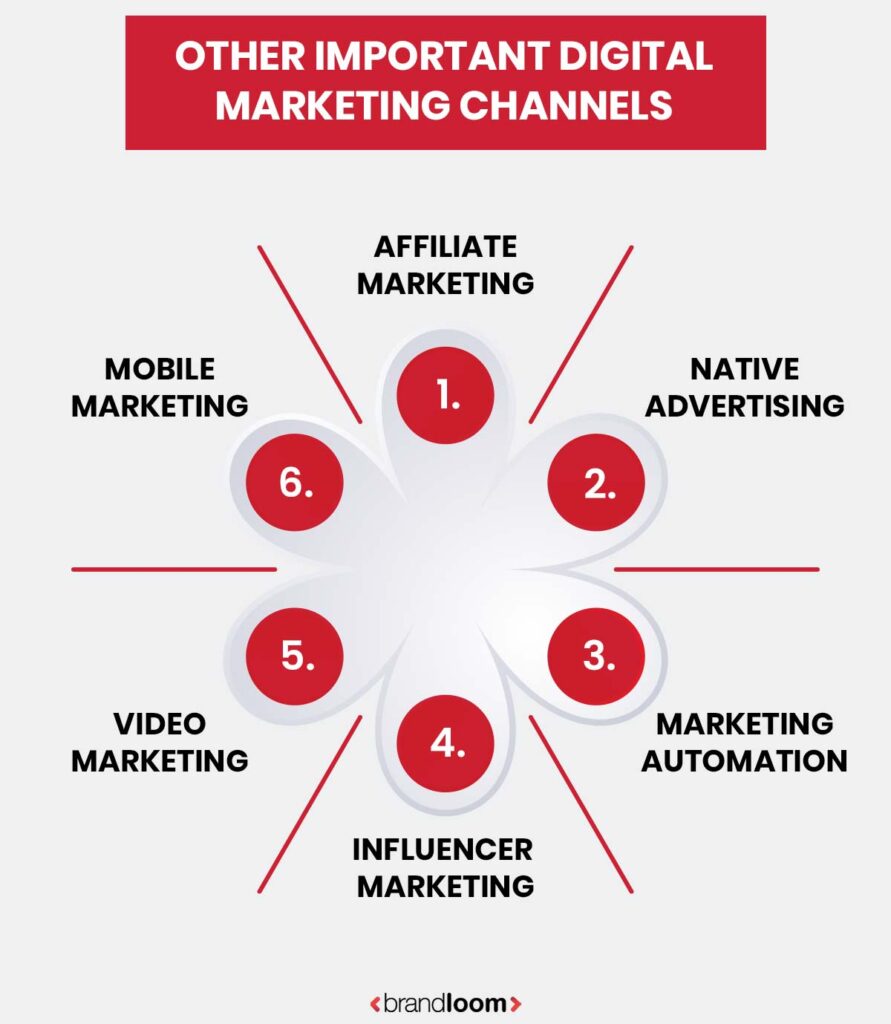
1. Affiliate Marketing
Affiliate marketing is a strategy where businesses partner with affiliates to promote their products or services. Affiliates share these promotions with their followers and earn a commission or a fixed fee when someone buys through their link. While similar to influencer marketing, the key difference is that affiliates only get paid when their referral leads to a sale.
This strategy mostly seeks the help of someone with an existing platform and an audience who already trusts them. If the affiliate recommends your brand, their followers are more likely to trust your business.
Affiliate marketing works in many ways. Some affiliates create product reviews or unboxing videos. Others may use your product and share links in their content directly.
Affiliates usually add promotions within useful content. This makes it more likely for your audience to notice and engage. For example, a YouTube smartphone reviewer might promote a smartphone brand or a TikTok makeup creator might review eyeliners. Affiliates often use unique codes or URLs that help track their sales and results.
2. Native Advertising
This is a paid marketing method where ads match the style and format of the platform on which they appear. These ads don’t look like typical ads. Instead, they blend in with regular content, making them feel more natural. For example, a brand might create a Facebook ad that looks like a regular post or a sponsored article that appears like a news story.
Native ads work by offering useful or entertaining content while keeping promotions subtle. Many brands use native advertising because people distrust traditional ads. Shoppers often think regular ads are biased and ignore them. Native ads solve this problem by fitting smoothly into the content users already engage with.
The challenge with native ads is balancing subtlety and honesty. Even though the ad blends in, it must be clear that it’s paid content. Labels like “sponsored” or “promoted” help maintain transparency. Users often respond better to native ads because they don’t interrupt the experience as traditional ads do.
3. Marketing Automation
Marketing Automation is a strategy that uses software to simplify and speed up marketing tasks. It relies on AI and machine learning to manage digital campaigns. While it doesn’t replace people, it takes care of routine tasks. This frees marketers to focus on big-picture planning and creativity.
For example: Abandoned cart recovery: Sending an automated email to customers who left items in their cart to encourage them to complete their purchase. You can also resend the email after a few days with a discount coupon.
Another example of marketing automation is sending a personalized birthday greeting to a customer.
Marketing automation tools are helpful for small or busy marketing teams. These tools can:
- Organize marketing tasks and workflows.
- Track results and performance.
- Calculate return on investment (ROI).
- Identify what’s working and what isn’t.
Automation helps you process large amounts of customer data quickly. These insights allow you to create more personalized campaigns. The results include better chances of converting leads into sales.
4. Influencer Marketing
It is a strategy where brands promote their products or services through popular content creators on social media. This approach helps you reach an established audience that already trusts the influencer’s opinions.
Although influencer marketing is common in B2C industries, it works for B2B as well. Office supplies, software services, or other business products can benefit too. The key is choosing the right influencer for your audience.
Unlike affiliate marketing, influencers are usually paid a fixed fee, not a commission. They get paid for promoting your product, even if it doesn’t lead to direct sales. You can, however, add affiliate links to the content that influencers share to encourage more sales.
Platforms like TikTok show average engagement rates of 16%, making influencer marketing more popular than ever.
To get the best results, you need the right strategy, which includes choosing influencers who know your industry and have a strong reputation. Give the influencer guidelines on how to present your brand, including tone, language, and details. Also, create a clear, written agreement that outlines payment and expectations.
5. Video Marketing
You can use short or long videos to get your message across fast. Many platforms now encourage video ads.
YouTube and instagram are the top choices for video marketing. YouTube is a search engine, not just a social site. Many shoppers decide to buy after watching a brand on YouTube.
Video marketing is more powerful than you think, especially short-form videos that grab attention. You can create videos with just a smartphone. Use them on your website, social media, emails, and ads to connect with more people.
6. Mobile Marketing
Mobile marketing is a way to reach customers through their phones. It targets users on smartphones, tablets, and even smartwatches by using a variety of channels.
Earlier, mobile marketing only focussed on SMS, but now it’s more advanced.
For example, mobile-optimized websites help businesses reach customers directly on their phones. These websites are designed to work smoothly on mobile devices, making it easier for users to navigate and shop.
You can also connect with customers through email and mobile-first platforms like TikTok and Instagram. Such platforms focusing on mobile users are great for posting content or running ads.
Mobile apps offer another way to reach customers directly on their phones.
Since most people have their phones all the time, the messages sent through phones are sent at the right moment. Mobile marketing works like email but is more direct. Companies can see high returns with mobile marketing.
The Benefits of Digital Marketing
Your digital marketing strategy depends on your business type. There are two main types: B2B (business-to-business) and B2C (business-to-consumer).
B2B companies sell to other businesses. B2B marketing strategies focus on logic, facts, and long-term value. This process takes longer and requires careful planning. Many people are involved in making decisions and aim to build relationships and trust over time.
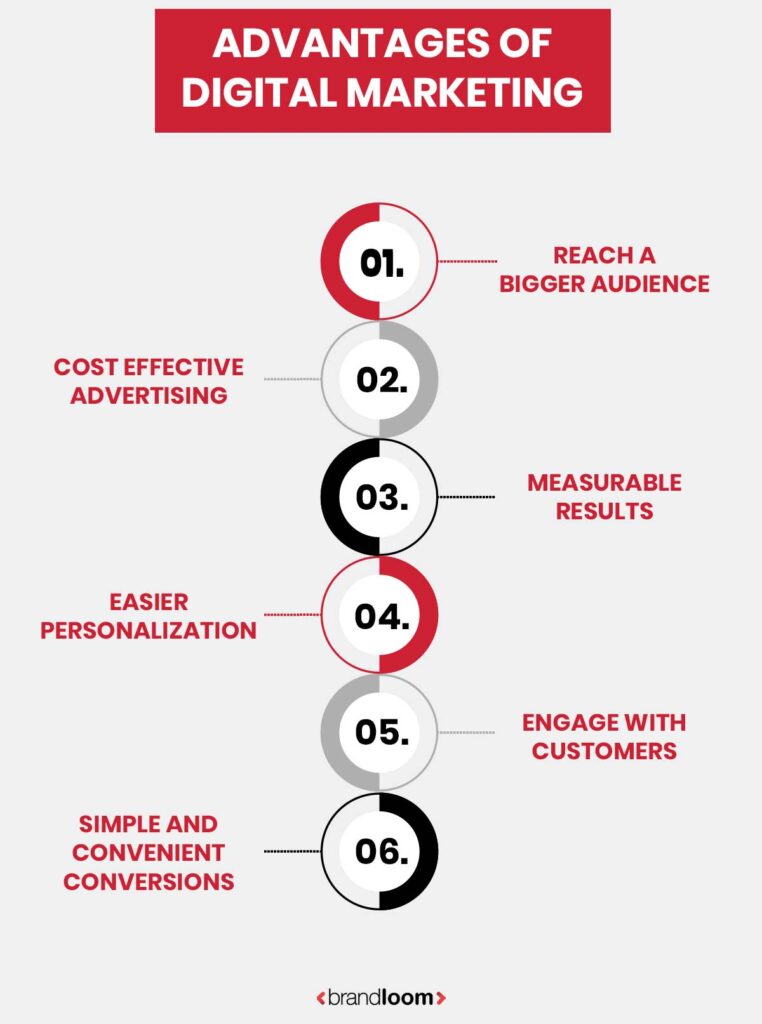
B2C companies sell directly to consumers. The buying process is faster and simpler. Usually, just one person makes the decision. B2C marketing uses short, urgent messages to get quick responses. Emotions often drive these decisions, so your messaging should connect with feelings.
No matter if you’re running a B2B or B2C business, digital marketing helps you understand your customers better and create personalized experiences across different platforms.
With digital marketing, you get to know your audience, understand their challenges, and track useful data that boost your marketing efforts. It brings a lot of benefits to the table:
1. Reach a Bigger Audience
Digital marketing makes it easy to reach a large audience with less effort. When you run an online ad, it can reach anyone around the world, no matter their location. You can connect with people in different time zones, just like placing an ad in the local newspaper, except on a global scale. It opens up new possibilities to grow your business far beyond your local area.
2. Cost-Effective Advertising
Traditional marketing channels like TV, radio, and print ads usually cost a lot more than digital options. Sharing content on social media or starting a blog is often free, aside from the time you spend creating content.
You can also build a professional website without breaking the bank, using existing templates or going for a custom build. Social media accounts are free to set up, and email services come at a reasonable price. Plus, digital content stays online as long as you maintain it, giving it more lasting power than temporary TV or newspaper ads.
3. Measurable Results
From website visits to ad conversions, you get clear data that shows how well your efforts are working. You can measure social media engagement, monitor blog traffic, and even track paid ad views, clicks, and conversions.
Unlike traditional marketing, which is harder to measure, digital marketing lets you gather both analytics and direct feedback from your audience, helping you fine-tune your strategy.
4. Easier Personalization
Digital marketing relies on customer data, which makes it easier to fine-tune your messages. You can track what your audience likes, where they are, and what they need, allowing you to personalize your campaigns.
You can also address customers by name in email campaigns or even wish them a happy birthday, making your messages feel more personal and connected.
5. Engage with Customers
Digital marketing is cost-effective and helps you connect with customers at every stage of their buying journey. You can use ads to attract leads and follow up after a purchase. This could include thanking them or suggesting related products. Traditional ads, like TV commercials, can’t offer this level of interaction.
6. Simple and Convenient Conversions
Digital marketing also makes it easy to turn potential customers into buyers. Thanks to its cross-channel nature, people can easily move from social media platforms to your online store and make a purchase. Plus, with automation, if a customer doesn’t buy right away, you can follow up quickly to remind them. This increases the chances of a sale.
What is a digital marketing strategy?
A digital marketing strategy is a plan to reach goals using online channels. It helps businesses grow, especially now when many people use their phones to shop or look for services.
With so much competition online, having a clear strategy helps you stand out and connect with the right audience. It also ensures you make the most of your time, money, and resources in this fast-paced digital world.
A solid strategy covers several key elements:
- Marketing Tools and Resources: These are the tools and content you’ll use, such as social media posts, SEO tools, blogs, email campaigns, videos, or paid ads. Be sure to test and update these tools regularly to stay ahead of trends and competitors.
- Target Audience: Identify who you want to reach. This includes details like their age, interests, online behavior, and the platforms they use. Creating audience personas can help you personalize your messaging for better engagement.
- Timing and Frequency: Plan when and how often to share your content or ads. Timing matters in the digital world. Posting at the right moments can boost engagement. Data insights from analytic tools help you identify the best times for your audience and adjust accordingly.
- Channels to Focus On: Decide which online platforms (like Facebook, Instagram, Google, or email) are best suited for your audience. Align your channel strategy with where your audience is most active and responsive to maximize impact.
- Goals and KPIs: Set clear objectives and key performance indicators (KPIs) to measure success. This could be website traffic, lead generation, or sales and conversions. Break down larger goals into smaller milestones to track progress more effectively.
Media Assets for a Better Marketing Strategy
To make a good strategy, businesses need to look at their media assets. These are divided into three types:
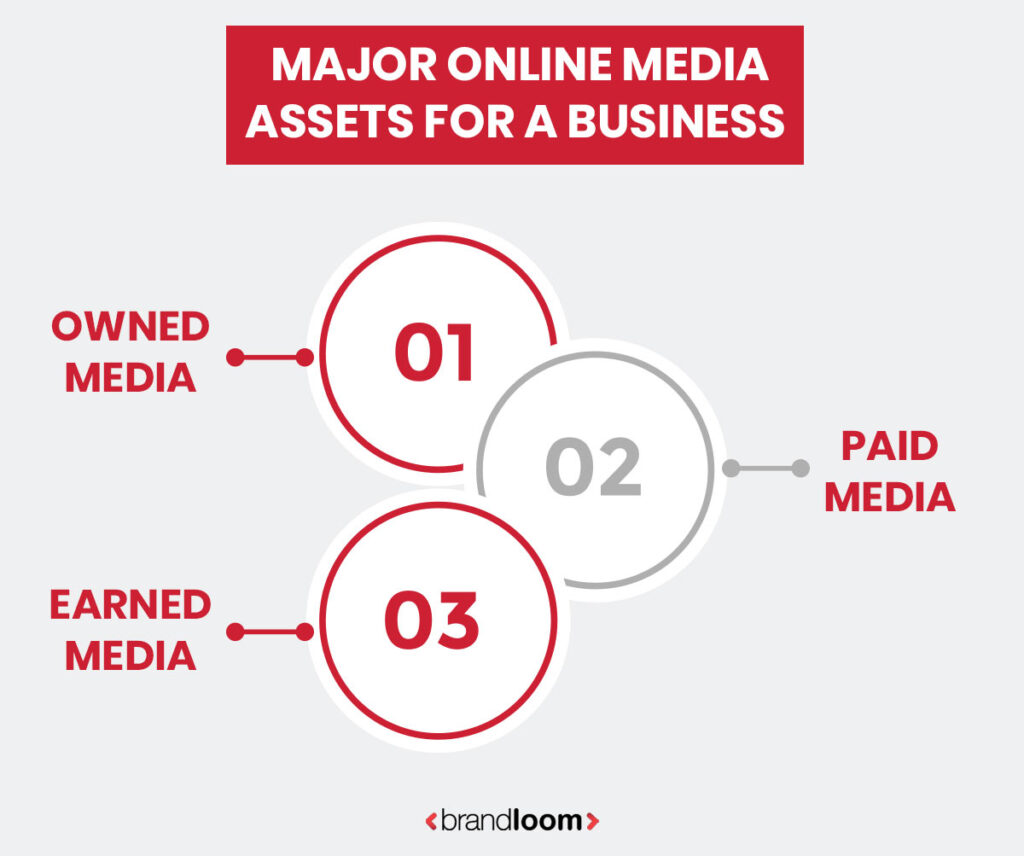
1. Owned Media
This is what the business owns and controls. It includes websites, blogs, videos, and podcasts. Businesses can use these tools in many ways to share their message.
2. Paid Media
This is what a business pays to show its content. Examples are ads, sponsored posts, or paying influencers to talk about the brand. Influencers play an important role in reaching more people.
3. Earned Media
This constitutes the media that others talk about a business without being paid. It includes reviews, awards, and testimonials. Happy customers sharing their experiences is a good example of earned media.
A strong digital marketing strategy combines owned, paid, and earned media. When used well, these help a business stand out and succeed online.
Tips to Create a Solid Digital Marketing Strategy
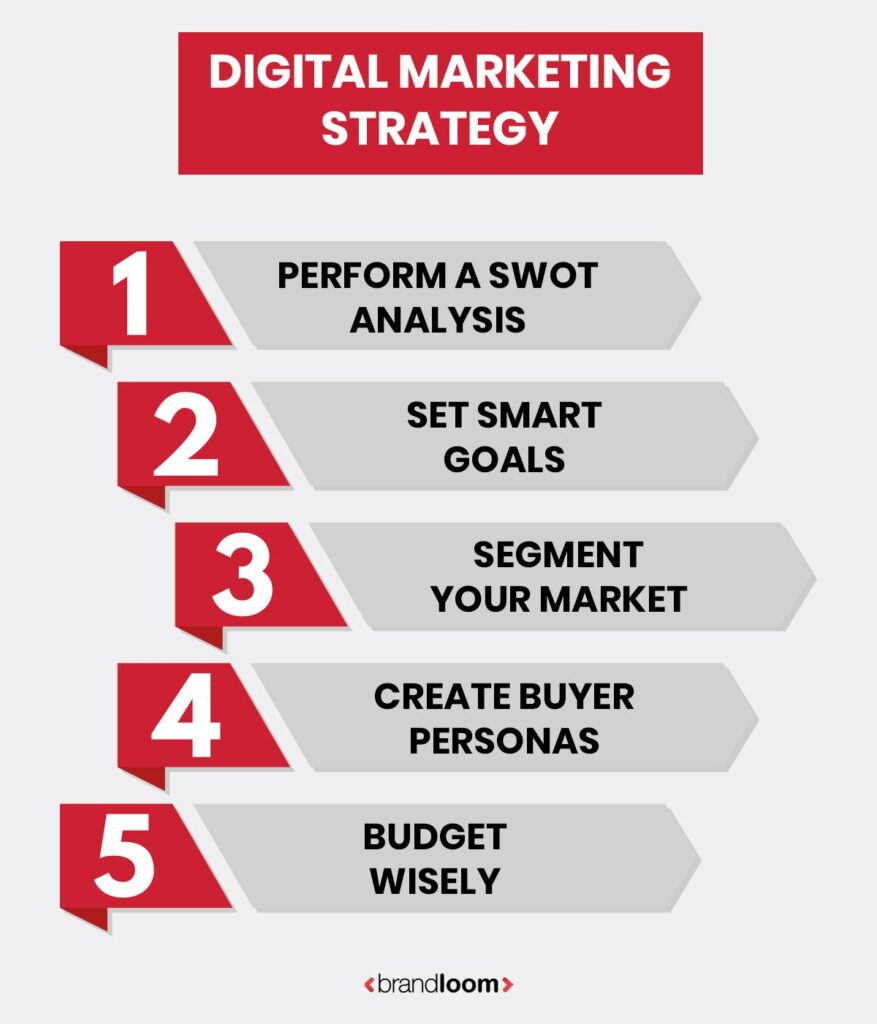
1. Perform a SWOT Analysis
SWOT stands for Strengths, Weaknesses, Opportunities, and Threats.
- Strengths: Internal factors like high sales, loyal customers, or a strong brand.
- Weaknesses: Issues like poor marketing, customer complaints, or lack of funds.
- Opportunities: Positive external factors, like new laws or market trends.
- Threats: Risks like rising costs, new competitors, or economic changes.
2. Set SMART Goals
SMART goals are Specific, Measurable, Attainable, Relevant, and Timely. These ensure your strategy stays on track. Ask questions like:
- What is the goal?
- How will progress be measured?
- Is it realistic?
Always back up your goals with metrics to track progress and adjust when needed. Key metrics include impressions, reach, clicks, engagement rate, conversions, and cost per lead (CPL).
Also, keep an eye on metrics like return on investment (ROI), return on ad spend (ROAS), attribution, and customer lifetime value (CLV). These help you measure the true impact of your campaigns.
3. Segment Your Market
Every audience is unique, so it’s important to understand who’s receiving your message. The target audience can differ across platforms, so take the time to learn about your followers on each one.
Divide your audience into specific groups based on the following:
- Demographic: Demographic classification is based on personal traits. This defines age, gender, location, etc.
- Firmographic: This is used for organizational classification based on aspects like Industry, revenue (B2B), and employee count.
- Psychographic: Psychographic segmentation categorizes prospects by looking at personality, opinions, goals, or lifestyle.
- Behavioral: To categorize prospects, behavioral segmentation looks at past purchases, brand loyalty, or usage trends.
4. Create Buyer Personas
Use market segments to build profiles of ideal customers. Buyer personas are made-up profiles of customers. They help businesses understand their customers better. These can be current, future, or ideal customers.
Each business may have different buyer personas. Marketers use them to group customers into segments. They look at behavior, interests, company details, and personal traits.
5. Budget Wisely
Ensure your strategy fits your financial limits. Even the best plans need proper funding to succeed. All organizations need a proper budget for digital marketing. Businesses should check their budget carefully. This helps them choose plans they can afford and make work.
Conclusion
Digital marketing helps businesses grow online. It helps enterprises of all sizes to reach more people, boost sales, and build strong brands. It works on many platforms like social media, websites, and email. With the right plan, online marketing can be easy to use and give great results for your business.
By utilizing the latest technology, BrandLoom makes digital marketing simple by offering customized Digital Marketing Services. As one of the best digital marketing agency in India, we create smart strategies to market your brand online.
Our team helps you get noticed and grow faster by utilizing the best strategies and channels of online marketing. So let us take the burden of increasing reach for your business while you focus on other productive aspects of your business growth.
Frequently Asked Questions
The fundamentals of digital marketing are:
Content: The main part that attracts and engages people.
Context: Making your strategy match your audience.
Community: Connecting and building a group with your audience.
Channels: Using platforms like social media, email, and websites to reach people.
Conversion: Turning leads into customers.
Some Fundamental channels of digital marketing are as follows –
SEO
Content Marketing
Email marketing
Social Media Marketing
Pay-per-click
Mobile Marketing
Affiliate/Influencer Marketing
These are the various benefits of Digital Marketing –
1. A large geographic scope
Posting an online ad allows it to be seen by anyone, as long as it isn’t limited by location settings. This makes it easy to expand your business’s reach and connect with a wider audience through different digital platforms.
2. Cost-effectiveness
Digital marketing not only reaches a wider audience compared to traditional methods but is also more affordable. Traditional options like TV ads or newspaper promotions often come with high costs.. Additionally, they give you less control over whether or not your target audiences will ever see those messages.
3. Measurable outcomes
Tracking results with digital marketing is simple and efficient. Whether open email rates, home page visits, or direct purchases, digital marketing tools, and the software automatically track the quantity of desired conversions you obtain.
4. Simpler personalization
You can collect customer data through digital marketing in a way that is not possible with offline marketing. Digital data is frequently much more precise and detailed.
5. Increased interaction with customers
Real-time communication with your customers ensures they interact with you. Customers gain from the interaction as well. As they actively engage in your brand’s narrative, their engagement level rises. A strong sense of brand loyalty may directly result from that sense of ownership.
As a leading digital marketing company in Delhi, BrandLoom’s digital marketing services can help you get the most out of utilizing this modern technology for business promotion.
The role of SEO in digital marketing is huge. Search Engine Optimization (SEO) helps make a website more visible in search results. When people search for specific products or services, SEO increases the chances of them finding your site. More visibility means more opportunities for your brand to gain customers.
The site’s placement commonly measures website visibility or ranking – on search engine results pages (SERPs). Businesses of all sizes always compete to maintain top positions on the first page, where they are most likely to get the most attention.
Being one of the top SEO agencies in Mumbai, Delhi and Bangalore our SEO digital marketing services can help your business website reach the top of search engine result pages.
Today, most consumers find out about businesses online through social media news feeds and Google search results. More than nine million businesses use Facebook to connect with customers, and companies can reach almost 1 million customers through Instagram alone.
The scope of digital marketing includes much more than just social media, even though posting ads and content on Facebook and other well-known platforms remains a successful way to reach your target audience. As more businesses enter the market and new technologies develop, digital marketing trends change constantly.
This is where an online marketing agency in Gurgaon, like BrandLoom, can help. With the right team and right technology, we are equipped with all the resources that can help you take your business to the next level through online marketing.
While traditional marketing techniques like TV and radio are still effective, businesses that are successful today have begun to rely on digital marketing. We live in a digital age, further fueled by the pandemic. This is why every business owner needs to be aware of the value of digital marketing.
Additionally, this has caused businesses to change and understand the importance of digital marketing and the use of appropriate digital marketing services in India that can help them advance. It is impossible to overstate how critical digital marketing is to a company’s success.
The role of digital marketing in India is of great significance. Contact us today to get the best digital marketing ideas for business transformation.
SEO stands for Search Engine Optimization. It’s a key part of digital marketing success. SEO helps websites show up higher on Google and other search engines. When you use the right keywords, good content, and quality links, your website becomes easier to find. SEO makes your site more visible to people looking for what you offer. This helps bring more visitors to your site without paying for ads. A well-optimized site loads fast and works on phones, too.
Digital marketing uses the internet, digital tools, and devices to promote your business. To advertise your business online, start by knowing your target audience. Use social media, blogs, emails, videos, and SEO to reach them. Create clear and engaging content. Post on platforms where your audience spends time, like Facebook or Instagram. Track your results using tools like Google Analytics. See what works best and improve your strategy. Be consistent with your efforts. Respond to your audience to build trust. Good strategies help you reach more people and grow your business online.
A digital marketing course teaches you how to promote businesses online. You learn about SEO, social media, email marketing, content creation, paid ads, etc. These courses often include hands-on projects to help you practice. They can be online or in a classroom. Some courses focus on specific skills like Google Ads or Facebook marketing. By the end, you understand how to attract and keep customers online. These courses are great for beginners or anyone who wants to grow their business.
Starting digital marketing is simple. First, learn the basics of SEO, social media, and email marketing. Pick a platform, like Email or social media like Instagram. Create content that your audience will like. Post regularly and track your results. Use free tools like Google Analytics to see what works. Practice writing blogs or running small ad campaigns. You don’t need to be an expert right away. Start small, learn from mistakes, and improve. Digital marketing takes time, but with effort, you’ll see results.

